Fuerteventura
Canary Islands, SpainFuerteventura is the second largest of Spain's Canary Islands. It is known for its amazing beaches, impressive sand dunes and unique volcanic landscapes.
On Ferryhopper, you will find useful information about your holidays: how to get there, best beaches and attractions, top activities, food recommendations, and ferry schedules. Compare prices and book ferry tickets to Fuerteventura online on Ferryhopper with no hidden fees!
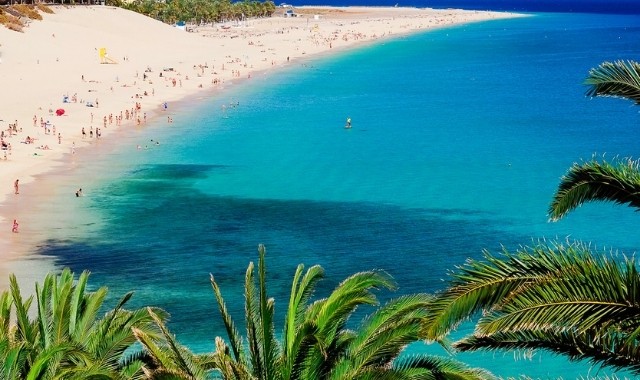
The heavenly turquoise waters and white sand of Matorral beach in Fuerteventura
Holidays in Fuerteventura
Fuerteventura is located 100 km off the coast of North Africa. With over 300 days of sunshine per year and low rainfall, Fuerteventura is the perfect year-round destination for seaside holidays.
Considered to be the best in the Canary Islands, Fuerteventura's beaches are truly spectacular! Τhe winds that blow throughout the year also make them the perfect place for water sports enthusiasts.
If you feel like taking a break from swimming and sunbathing, Fuerteventura's interior is equally impressive. We recommend exploring it to marvel at the endless rolling hills, volcanic mountains and vast plains. Not to mention the quiet picturesque villages that have remained untouched by time and are definitely worth a visit.

The unique landscape of Fuerteventura
How to get to Fuerteventura
Fuerteventura is easily accessible by plane and of course, by ferry.
The easiest way to travel to Fuerteventura by ferry is from the neighboring island of Lanzarote. There are several daily crossings from Lanzarote to Fuerteventura all year round and the duration of the shortest ferry trip is only 25 minutes.
Alternatively, you can fly directly to Fuerteventura via both domestic and international flights. Fuerteventura’s international airport (El Matorral Airport) is located 5 km from the port and the capital of Puerto del Rosario and 40 km from Corralejo.
You can find more information about Fuerteventura ferry schedules and tickets here.
What to do in Fuerteventura
Holidays in Fuerteventura are all about the beach: swimming, sunbathing and doing water sports are the main activities on the island. But there is more to Fuerteventura than gorgeous beaches. From endless sand dunes to imposing mountains, the island is full of unique natural sights for you to explore.
To catch a glimpse of Fuerteventura's peaceful rural life and learn more about its history, you can visit the island's pretty villages and towns as well as its museums. And don't miss the chance to try the delicious local products and dishes!
Sounds exciting? Keep reading our guide to Fuerteventura for more information about your vacation on the island, including what to do in Fuerteventura, things to see, useful information and travel tips.
Tip: during your Fuerteventura vacation, you should not miss the chance to go on a dolphin and whale watching tour. Seeing the impressive animals in the wild is an experience you will never forget!
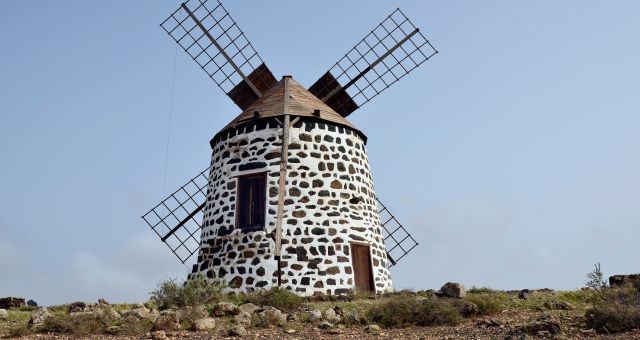
Traditional windmill near the sand dunes of Corralejo
Beaches in Fuerteventura
Boasting almost 150 km of fantastic beaches, Fuerteventura is the perfect destination to enjoy the sea. From long beaches with white sand and saltwater lagoons to rock-framed coves and coasts surrounded by sand dunes, the island has so many impressive beaches that you will not know which one to choose.
Here are 10 of the best beaches in Fuerteventura:
- Sotavento: comprising 5 beaches, the Sotavento coast is protected by a nature reserve. Thanks to steady trade winds, this 5 km-long stretch of shoreline is one of the best locations in the Canary Islands for kite-surfing.
- Matorral or La Solana: this 4 km long beach is lined with shops, leisure centers and restaurants. You will also find there Saladar de Jandía, a Site of Scientific Interest.
- Caleta de Fuste or El Castillo: this half-moon bay is located on the eastern side of Fuerteventura. Thanks to its powder-soft sand and calm waters all year round, this 800 m beach is very popular among families.
- Corralejo: located in the northeast of the island, the Great Beaches of Corralejo are bordered by the Corralejo Dunes, the largest in the Canary Islands. These 9 km beaches with turquoise waters don’t offer shade, so make sure to go prepared.
- Esmeralda: as the name of the beach suggests, the sea here is emerald green, the sand is soft and the waters are calm. Close to the beach you’ll find resorts, restaurants and bars.
- La Concha: this 200 m beach with fine white sand and crystal clear turquoise waters is situated close to the fishing village of El Cotillo. Make sure to stay until sunset!
- Esquinzo: not to be confused with the more touristy Esquinzo-Butihondo, Esquinzo beach is a rock-framed cove and a magnet for surfers year-round.
- El Aljibe de la Cueva: characterized by soft golden sand and volcanic cliffs, El Ajibe is a long and broad beach located close to El Cotillo. Thanks to its lack of shade and services, you might well have it all to yourself.
- Popcorn: instead of rocks, pebbles, or sand, this beach is actually covered in small white algae fossils that look just like popcorn! Find out more about Popcorn beach on our relevant blog.
- Cofete: located in the south of Fuerteventura, this 12 km beach is characterized by dramatically crumbling cliffs. The only way to get here is by following a rough road for 20 km, so it’s rarely crowded.
Tip: go on a day trip from Fuerteventura to Lobos, a protected islet with heavenly beaches located just 2 km north of the island. Ferries to Lobos depart daily from Corralejo and the ride takes only 15 minutes.
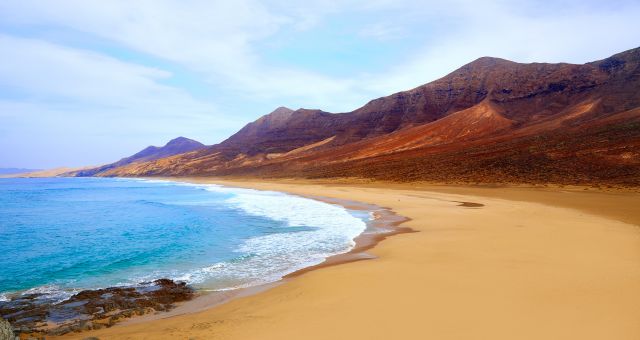
The dramatically crumbling cliffs of Cofete beach in Fuerteventura
Sightseeing in Fuerteventura
Wondering what to see in Fuerteventura? Designated as a biosphere reserve by UNESCO due to its ecosystem diversity, the island is full of stunning natural sights. There are also many cultural attractions and museums that you can explore to learn more about Fuerteventura's history and traditions.
Here are some cultural and natural attractions that we recommend you don`t miss:
The best cultural attractions in Fuerteventura
- The Punta Jandía lighthouse
- The mysterious Villa Winter
- The Del Carmen Saltworks Museum
- The Los Molinos Visitor Center and windmill in Tiscamanita
- The Entallada lighthouse
- The Risco de las Peñas viewpoint
- La Atalayita
The best natural attractions in Fuerteventura
- The Jandía Nature Reserve
- The Sacred Mountain of Tindaya
- The Betancuria Rural Park
- The Calderón Hondo volcano
- Oasis Wildlife for the rescue and recovery of species
- The Corralejo Natural Park with its endless sand dunes
- The aloe vera fields
- The Ajuy caves
- Pico de la Zarza, the highest point in Fuerteventura
View of the impressive Calderón Hondo volcano in Fuerteventura
Nightlife in Fuerteventura
Compared to other Canary Islands, such as Tenerife, Fuerteventura has a more low-key nightlife and chilled-out vibe. The best place for a night out is Corralejo, a popular tourist resort in the north of the island. There, you will find several bars where you can listen to live music, drink great cocktails and sing karaoke.
If you feel like dancing and partying, there are some nightclubs and discos that stay open until the early hours of the morning.
Puerto del Rosario, Fuerteventura's capital, also has some great bars and clubs, most of which are located in the area around the port.
Food in Fuerteventura
Characterized by the use of fresh local ingredients, Fuerteventura's cuisine is a fusion of various Mediterranean influences, mainly Spanish. Fish-based dishes feature prominently on restaurant menus.
During your holidays in Fuerteventura, we suggest that you try the following local dishes and products:
- queso majorero (a type of cheese made of goat's milk)
- papas arrugadas (boiled potatoes served with spicy garlic sauce)
- mojo verde (coriander-based garlic sauce) and mojo rojo (red pepper garlic sauce)
- gofio (type of Canarian flour made from roasted grains)
- pejines and jareas (sun-dried salted fish)
- sancocho (fish stew with potatoes)
- mussels
- braised or roasted goat
Tip: don't miss the chance to visit the Majorero Cheese Museum to learn more about Fuerteventura's rich cheese-making tradition and taste the award-winning cheese!
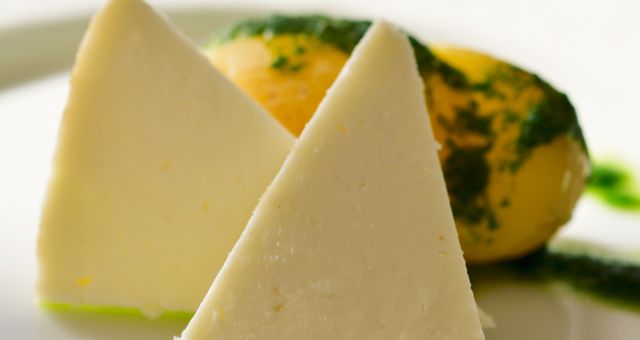
A slice of the delicious Majorero cheese, Fuerteventura's most famous traditional product
Towns and villages in Fuerteventura
The capital and biggest port in Fuerteventura is Puerto del Rosario. The city has some impressive street art and more than 100 statues made by local and international artists. Puerto del Rosario's waterfront promenade is also the perfect place for taking a walk or just enjoying great views of the sea.
If you prefer to get away from the crowds, Fuerteventura's charming villages are more peaceful and have some great restaurants and beaches as well as impressive natural sights and monuments.
Here are some of the best places to visit in Fuerteventura:
- Corralejo
- Morro Jable
- Betancuria
- El Cotillo
- Puertito de Los Molinos
- Lajares
- Giniginamar
- Tuineje
- Pájara
Tip: the artisan markets in La Oliva and Lajares are the perfect place to shop for local products, from traditional delicacies and fresh produce to spices and hand-made jewelry.
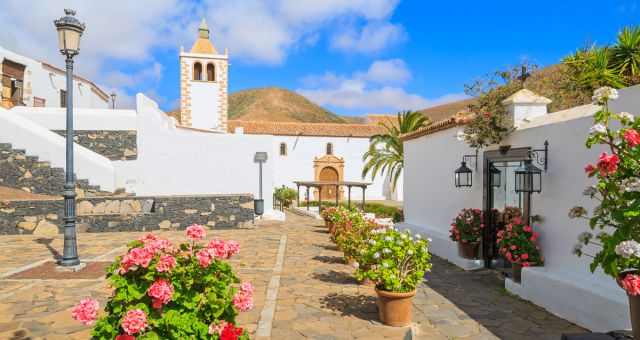
The beautiful church of Santa María in Betancuria, the old capital of Fuerteventura
Useful information about Fuerteventura
Located close to the coast of North Africa, Fuerteventura is the second largest of the Canary Islands after Tenerife and offers all kinds of amenities for visitors.
Fuerteventura offers many accommodation options for different budgets. If you're wondering which is the best area to stay in Fuerteventura, some of the most popular resorts are Corralejo, Caleta de Fuste and Morro Jable.
Corralejo has the best nightlife on the island, while Caleta de Fuste is great for family holidays in Fuerteventura. Morro Jable is more peaceful than Corralejo and offers easy access to the stunning beaches of the Jandía peninsula and to the Jandía Natural Park.
The island's hospital is in Puerto del Rosario, the capital, and there are also medical centers in several towns and villages.
If you love the heat, the best months to visit Fuerteventura are July and August. Bear in mind, though, that the island gets quite busy during that time. Late spring or early summer is also a good time to travel to Fuerteventura, with peak temperatures in the mid-20s and minimal rainfall. March and April are warm as well, with temperatures around 22ºC during the day and 18ºC at night.
Important phone numbers for your stay in Fuerteventura
Here are some useful contacts to keep handy during your trip to Fuerteventura:
- Puerto del Rosario tourist information office: +34618527668
- Puerto del Rosario Port Authority: +34928214700
- Fuerteventura Airport (or El Matorral Airport): +34913211000
- Fuerteventura General Hospital (Puerto del Rosario): +34928862000
- Corralejo Medical Center (Centro de Salud Corralejo): +34928303969
- Local police: 092
- Medical emergencies: 061
- European emergency number: 112

The gorgeous Sotavento beach in Fuerteventura
Transportation in Fuerteventura
Fuerteventura is the longest of the Canary Islands, so distances can sometimes be bigger than you would expect.
The island has an extensive public bus network, but smaller towns and villages are connected by infrequent services. Fares can quickly add up for longer-distance connections.
You should also bear in mind that the airport is not well-connected to all areas of the island. If there is no direct bus route between the airport and your destination, you will have to change buses at Puerto del Rosario. For more information on bus routes and timetables, you can visit the official Fuerteventura transport service website.
You can also get around Fuerteventura by taxi, but keep in mind that the fare can be quite expensive for long-distance rides. Alternatively, you can hire a car to explore the island at your leisure and get the chance to visit beaches and villages that are not easily accessible without a vehicle.
Ports in Fuerteventura
Fuerteventura has 3 ports: Puerto del Rosario, Corralejo and Morro Jable.
Puerto del Rosario, in the east of the island, is the main port and capital of Fuerteventura. Close to the harbor you’ll find a supermarket, shops and a wide range of hotels to choose from.
Corralejo is located in the north, just a 5 minute walk from Corralejo. From here, you can easily sail away to Lanzarote or the wild Isle of Lobos. Finally, Morro Jable, on the south coast, is the closest to the neighboring island of Gran Canaria. Close to the harbor you’ll find a number of cafés. Corralejo and Morro Jable are located 31 km and 89 km respectively from Puerto del Rosario.

The Tostón lighthouse on the northwestern coast of Fuerteventura
Island hopping from Fuerteventura
From Fuerteventura, you can easily travel by ferry to Lanzarote, Gran Canaria and Tenerife.
Here's some additional information about them:
- Lanzarote: ferries from Fuerteventura to Lanzarote depart several times per day from the port of Corralejo and arrive at the port of Playa Blanca. The ferry ride takes only 25-35 minutes.
- Gran Canaria: most ferries from Fuerteventura to Gran Canaria leave from the port of Morro Jable, while there are a few weekly departures from Puerto del Rosario. The shortest journey from Fuerteventura to Gran Canaria takes 2 hours, with ferries departing from Morro Jable.
- Tenerife: ferry routes from Fuerteventura to Tenerife are indirect and include a stopover in Las Palmas (Gran Canaria). There are several indirect Fuerteventura - Tenerife ferry options available daily, lasting around 5 hours.
Tip: on Ferryhopper's Map of ferries, you can see all the available ferry routes from Fuerteventura, so that you can easily organize your island hopping in the Canary Islands.
Fuerteventura ferry: schedules and tickets
You can travel by ferry to Fuerteventura island from the port of Cádiz in mainland Spain. Keep in mind that the ferry route from Cádiz to Fuerteventura is indirect and includes a stopover at the port of Arrecife in Lanzarote. The indirect route is usually available once a week, with the trip lasting around 30 hours.
Book your ferry tickets to Fuerteventura online
Book ferry tickets to Fuerteventura online on Ferryhopper with no hidden costs. Compare trip duration, companies and ticket prices, and organize your trip to Fuerteventura and the Canary Islands with just a few clicks!
Fuerteventura ferry schedule
View the complete ferry schedule from and to Fuerteventura for the upcoming week. Find up-to-date trip information, including departure and arrival dates and times, ferry operators and ticket prices.
